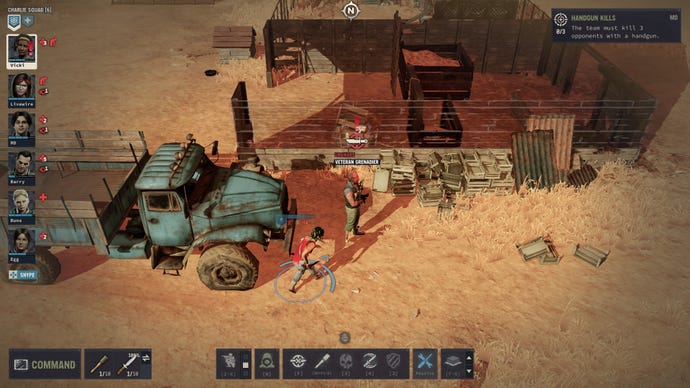I will definitely continue to play Jagged Alliance 3. While I’m hesitant about my exact feelings on this, it’s crucial. As with its ancestors, you invade a fictional country with a team of dysfunctional freelance mercenaries, managing their equipment and taking on personalities through guerrilla warfare on an open world map each sector of which can host turn-based battles.
It defies the stifling XCOM norm of “two actions per turn” by restoring the old action point method. Each has a dozen action points per turn to split between moving, shooting, or various contextual actions. Chance to hit is never listed, but accuracy can be increased by spending extra action points. It also breaks new ground by giving everyone a small reserve of freedom of movement, keeping battles moving and expanding tactical possibilities. It borrows so much from modern designs and is mostly better for it.
Manage cookie settings
Watch on YouTube
Characters automatically reload between fights and supplement personal inventories with those of the squad if possible. Targeting specific body parts now inflicts status effects like suppressed or reduced accuracy, and each weapon class adds a special attack, like machine guns holding a lane or dashing while spraying multiple pot shots with an SMG. Gun mods are made from spare parts rather than bought or found. Characters now gain perks when leveling up, but these are limited by their stats to ward off minmaxing and address the other defining element of the series: unique characters.
The characters are…good. Mechanically they are excellent. There are no classes, and everyone’s skills vary wildly, but as they improve with use, you can shape people however you see fit. They each get a unique ability, adding a little character without ranking them. They also have personality, or rather, they have one thing that they will constantly tell you about. Buns are effective. Meltdown is now an insufferable tryhard. Ice is a Black American Guy, as seen on TV.
They constantly jump into conversations with obnoxious comments too, until I started picking the most annoying professional characters because they were less likely to show up in my replies, which embarrassed me. I’ve become a fan of some (like newcomer Livewire, a cute Pakistani hacker whose hacking bonus pays his salary before you even give him a decent gun), but most were insufferable enough to give up for good just to shut them up. He’s not as sharp as the originals (although he’s less mean) and isn’t confident enough to stop talking about how confident he is. It’s not well-written or funny enough to elevate them from simple backstory to successful parody.
I don’t care about the plot and I remember the name of exactly one NPC. Its setting is not entirely comfortable, especially since your employer is a diamond mining company. It’s pretty clear that they’re the wrong ones and something will probably come out of it, but so far I’m really only in a fictional African country shooting dudes for money, which is the motif that Far Cry 2 covered less uncomfortably in 2008. I didn’t detect any malevolent vibes or edgelords, and a game about mercenary guerrillas will naturally visit unlucky, war-torn countries. But it’s pretty boring at best to see Africa once again reduced to slums, warlords and shamans, and the writing just doesn’t carry the wry personality that might pull it out of this quagmire.
There are many side jobs and hidden things to his credit, and his card is incredibly open. Sectors are smaller but more interesting than before, with fewer empty jungles to navigate and many maps taking full advantage of the 3D engine with multiple elevations. There are steeds to ambush now, but these suffer from that perennial turn-based shooter problem: stealth.
All travel happens in real time until someone starts, and we move on to turns. Before that, you can sneak up and stealth kill sentries. Enemies that spot you do the completely bullshit “free turn to run to cover the thing” like in XCOM, so you’ll want to set up ambushes. But you have to do it in real time, slowly controlling everyone in turn, even when the enemy comes out of the kill zone. The “prepare for withdrawal” option helps, but not much.
JA3 ditched interrupts in favor of a surveillance system, thankfully via the Phoenix Point/Stirring Abyss model of setting a specific firing range. But mercenaries immediately shoot the center of mass rather than letting you decide what to do. This bothers me more than most players. Reversing that is the chance to hit the system, which I love but will alienate people after a decade of tactical games that pamper you with accurate odds. Katharine was right to say that it is strange to give so much information except your exact chance to hit, but I was blindsided immediately, including the damage numbers, favoring my intuition instead. Jagged Alliance 3 is an eyeball simulation game, not boring board game calculations. A table is not “-5% enemy accuracy”; it’s “better than nothing and maybe worth drawing fire from my sniper or pressuring the flanking guys and from there the full auto might hit them both”. You will try your luck because it looks like it’s worth throwing a few random balls this way, especially since the repeated shots increase accuracy.



And that’s why I’m going to play it more: the combat, the heart of it, is really damn good. The shootouts are varied and chaotic, the tactical challenge is real enough that I never felt like I lost by chance, but because I didn’t bring in enough guys, or put too much pressure on a key mercenary, or didn’t cover someone’s position properly. I replayed a few shootouts just for fun and to experiment. I take advantage of it! Where XCOM bored me insane, and succeeding at Phoenix Point made me feel more villainous than triumphant, I love every win, and a hell of a lot of individual moments where Ivan takes turns zapping two dudes, Vicky flanks a sucker, or Ice completely chops a dude with his machete.
I think it’s a success. It’s a strong push to move the genre beyond the model we’ve been stagnant in for years that still recognizes the strengths of this design (so far it’s copying some things I wish it didn’t, like the divine panic system). It will be divisive for that, and may also alienate the most stubborn purists, which it really doesn’t deserve. Tonally, it’s mostly a miss, and aspects of its UI like travel, merchant selection, transfer, and inventory splitting require another quality-of-life pass. But the combat/strategy/management elements are enough to get him through those disappointments, and I suspect will keep me coming back for a while.
This review is based on a review version of the game provided by publisher THQ Nordic


